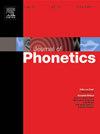21世纪语音学的进展:定量数据分析
IF 2.4
1区 文学
0 LANGUAGE & LINGUISTICS
引用次数: 0
摘要
21世纪的语音研究很大程度上依赖于定量分析。本文回顾了常用实践的演变和新技术的出现。通过详细的文献调查,我们发现大多数工作遵循一个主流,随着时间的推移,它已经从方差分析转向混合效应回归模型。除了这一主流之外,我们还强调越来越多地使用多样化的方法工具箱,特别是贝叶斯方法和动态方法,我们对此进行了全面的回顾。贝叶斯方法,以及超越线性和逻辑回归的频率方法,在模型规范、解释和合并先验知识方面提供了灵活性。动态方法,如GAMs和功能数据分析,捕获声学和发音数据中的非线性模式。机器学习技术,如随机森林,扩展了语音学家可以分析的问题和数据类型。我们还讨论了促进可复制性和透明度的开放科学实践日益增长的重要性。我们认为,未来在于一个多样化的方法工具箱,根据研究问题和数据结构选择技术。本文章由计算机程序翻译,如有差异,请以英文原文为准。
Advancements of phonetics in the 21st century: Quantitative data analysis
Phonetic research in the 21st century has relied heavily on quantitative analysis. This article reviews the evolution of common practices and the emergence of newer techniques. Using a detailed literature survey, we show that most work follows a mainstream, which has shifted from ANOVAs to mixed-effects regression models over time. Alongside this mainstream, we highlight the increasing use of a diverse methodological toolbox, especially Bayesian methods and dynamic methods, for which we provide comprehensive reviews. Bayesian methods, as well as frequentist methods beyond linear and logistic regression, offer flexibility in model specification, interpretation, and incorporation of prior knowledge. Dynamic methods, such as GAMs and functional data analysis, capture non-linear patterns in acoustic and articulatory data. Machine learning techniques, such as random forests, expand the questions and types of data phoneticians can analyze. We also discuss the growing importance of open science practices promoting replicability and transparency. We argue that the future lies in a diverse methodological toolbox, with techniques chosen based on research questions and data structure.
求助全文
通过发布文献求助,成功后即可免费获取论文全文。
去求助
来源期刊

Journal of Phonetics
Multiple-
CiteScore
3.50
自引率
26.30%
发文量
49
期刊介绍:
The Journal of Phonetics publishes papers of an experimental or theoretical nature that deal with phonetic aspects of language and linguistic communication processes. Papers dealing with technological and/or pathological topics, or papers of an interdisciplinary nature are also suitable, provided that linguistic-phonetic principles underlie the work reported. Regular articles, review articles, and letters to the editor are published. Themed issues are also published, devoted entirely to a specific subject of interest within the field of phonetics.
 求助内容:
求助内容: 应助结果提醒方式:
应助结果提醒方式:


